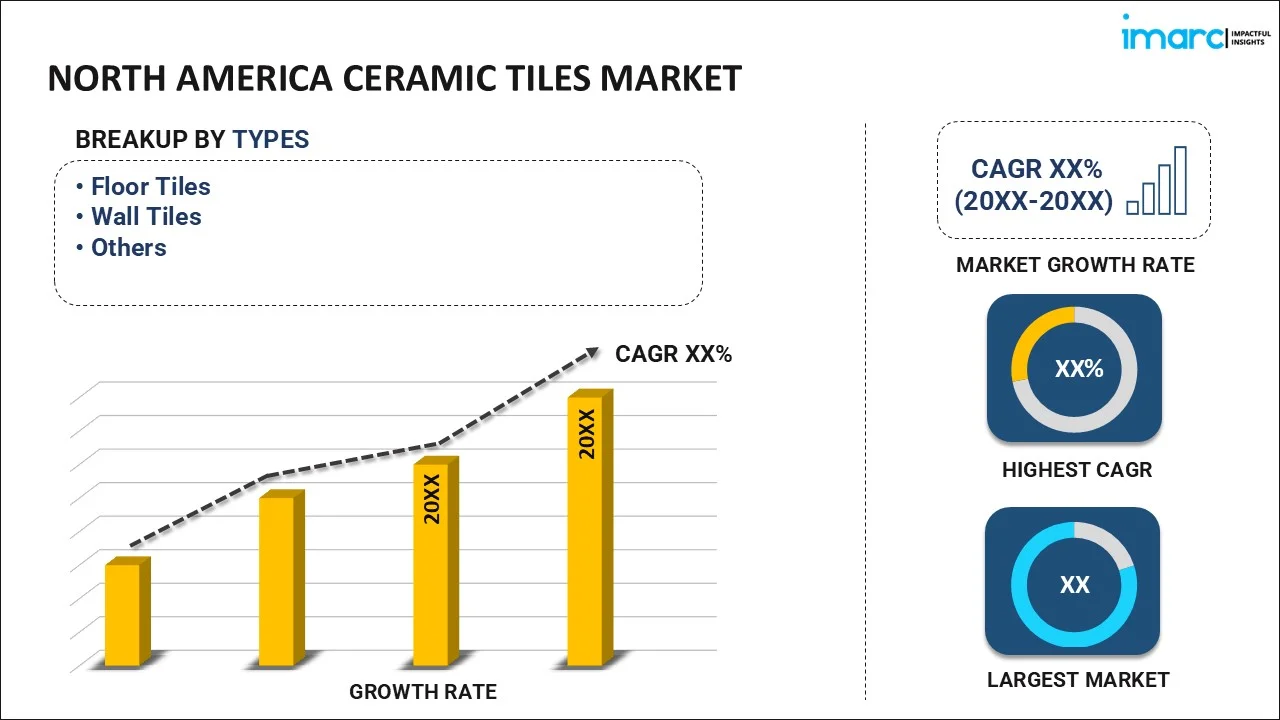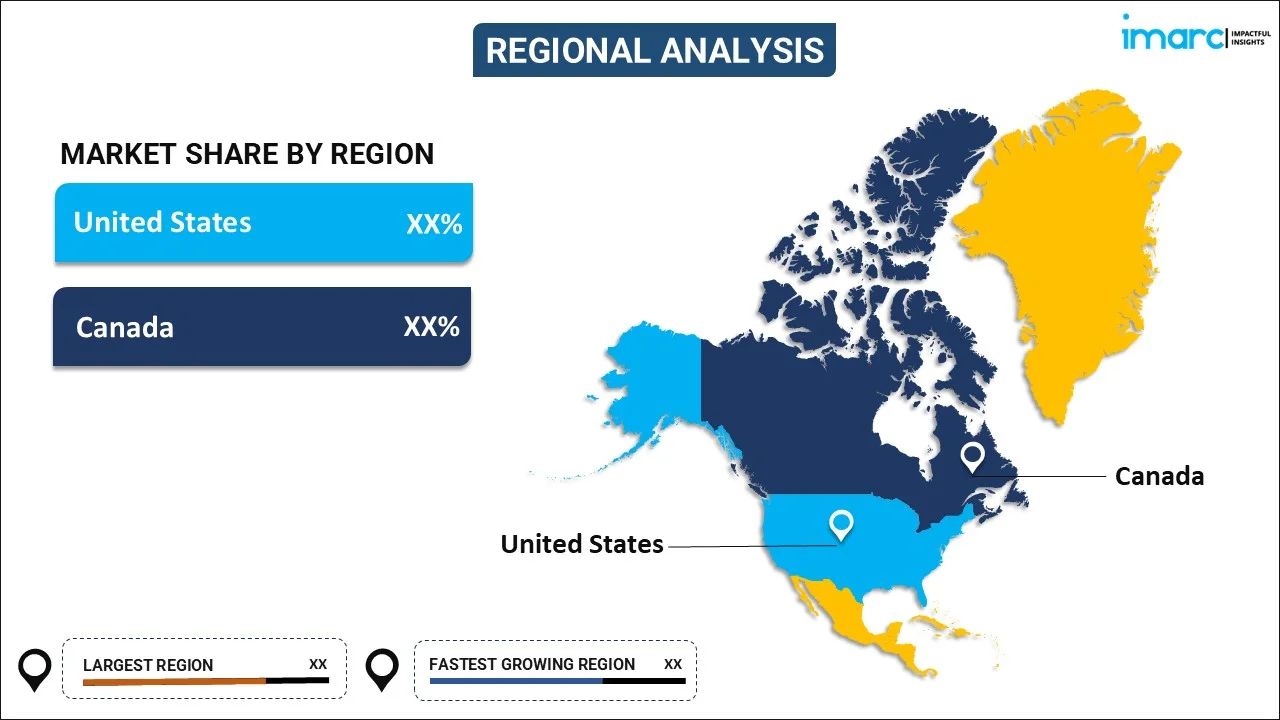
North America Ceramic Tiles Market Report by Type (Floor Tiles, Wall Tiles, and Others), Application (Residential Applications, Commercial Applications, Replacement Applications), and Region 2025-2033
Market Overview:
The North America ceramic tiles market size reached USD 23.8 Billion in 2024. Looking forward, IMARC Group expects the market to reach USD 36.4 Billion by 2033, exhibiting a growth rate (CAGR) of 4.8% during 2025-2033. Growing construction and infrastructure development, increasing renovation and remodeling activities, rising environmental consciousness, and the wide product availability in various designs, shapes, colors, and sizes are some of the major factors propelling the market.
|
Report Attribute
|
Key Statistics
|
|---|---|
|
Base Year
|
2024 |
|
Forecast Years
|
2025-2033 |
|
Historical Years
|
2019-2024
|
| Market Size in 2024 | USD 23.8 Billion |
| Market Forecast in 2033 | USD 36.4 Billion |
| Market Growth Rate (2025-2033) | 4.8% |
Ceramic tiles are thin, flat-surfaced slabs used in commercial and residential spaces. They are manufactured from a mixture of natural and hard-wearing materials, such as clay, kaolin, bentonite, feldspar, quartz, magnesite, dolomite, talc, limestone, and calcium phosphate. Ceramic tiles are usually molded to form rectangular or square shapes and are commercially available in various designs, thicknesses, textures, widths, shapes, colors, weights, and sizes to improve the aesthetic value of a space. They are strong, lightweight, cost-effective, and highly durable products that are easy to install, clean, and wash. Ceramic tiles also exhibit anti-skid and anti-bacterial properties and resistance against dirt, moisture, scratch, chemicals, and stains.
Significant growth in the construction industry is one of the key factors creating a positive outlook for the market in the region. Ceramic tiles are widely used in floors, walls, roofs, ceilings, countertops, and worktops in kitchens, bathrooms, basements, swimming pools, laundry rooms, fireplaces, bar areas, corporate offices, hotels, shops, restaurants, and museums, as they are extremely strong, visually appealing, slip-resistant, and easy to maintain. In line with this, the widespread product adoption as an ideal alternative to hardwood, especially in constructing green buildings, is acting as another growth-inducing factor. Furthermore, continual advancements in production technology and the launch of anti-skid and anti-scratch product variants in the market are acting as another growth-inducing factor. Besides this, rising expenditure capacities of consumers and increasing customization and personalization trends are supporting the market growth.
North America Ceramic Tiles Market Trends/Drivers:
Significant growth in the construction industry
Ceramic tiles are widely used in the construction of residential and commercial buildings, such as houses, apartments, offices, retail spaces, hotels, restaurants, healthcare facilities, and condominiums. In line with this, the widespread product adoption due to their durability, aesthetic appeal, and ease of maintenance is acting as another growth-inducing factor. Moreover, the increasing product utilization in the hospitality and tourism industries to create a welcoming and stylish atmosphere is propelling the market growth. Other factors, including rising renovation and remodeling activities in both residential and commercial sectors and the implementation of various government initiatives to invest heavily in infrastructure development, including roads, bridges, airports, and railways, are supporting the market growth.
The rising environmental consciousness among the masses
Consumers are increasingly seeking sustainable and eco-friendly options, including ceramic tiles, for their construction and design projects, as they are typically made from natural materials such as clay, sand, and minerals. In addition to this, these tiles do not emit volatile organic compounds (VOCs) or other harmful substances into the indoor air, making them a healthier choice for indoor environments. Furthermore, the increasing product demand due to longevity, as it reduces the need for frequent replacements and minimizes waste generation, is positively influencing the market growth.
Extensive research and development (R&D) activities
The North America ceramic tiles market is continuously evolving due to the extensive R&D activities leading to various innovations. The utilization of advanced techniques to enhance efficiency, reduce energy consumption, and minimize waste is propelling the market growth. Additionally, the introduction of digital printing to produce high-resolution images, patterns, and textures on ceramic tiles, mimicking the appearance of natural materials like wood, stone, or fabric, is providing an impetus to the market growth. Apart from this, manufacturers are launching slim or ultra-thin tiles that are easier to handle, install, and transport and offer versatility in applications, including wall cladding, furniture surfaces, and other creative uses, which, in turn, is creating a positive outlook for the market.
North America Ceramic Tiles Industry Segmentation:
IMARC Group provides an analysis of the key trends in each segment of the North America ceramic tiles market report, along with forecasts at the regional and country levels from 2025-2033. Our report has categorized the market based on type and application.
Breakup by Type:

- Floor Tiles
- Wall Tiles
- Others
Floor tiles dominate the North America ceramic tiles market
The report has provided a detailed breakup and analysis of the North America ceramic tiles market based on the type. This includes floor tiles, wall tiles, and others. According to the report, floor tiles represented the largest market segment.
Ceramic tiles are highly resistant to wear and tear, making them suitable for flooring applications. They are widely used in floors for residential, commercial, and industrial applications due to their durability and long lifespan. Additionally, ceramic floor tiles offer a wide range of design options, allowing homeowners, architects, and designers to achieve various aesthetics and styles as they are available in an extensive array of colors, patterns, textures, and finishes. Besides this, the widespread product adoption due to their easy-to-clean and maintain properties, as they do not easily trap dirt, dust, or allergens, is supporting the market growth.
Breakup by Application:
- Residential Applications
- Commercial Applications
- Replacement Applications
Residential represents the leading application segment
The report has provided a detailed breakup and analysis of the North America ceramic tiles market based on the application. This includes residential, commercial, and replacement applications. According to the report, residential represented the largest market segment.
Ceramic tiles are widely used as flooring materials in residential buildings as they offer durability, ease of maintenance, and a wide range of design options. Moreover, the widespread product adoption in residential entryways and foyers, due to their durability and ability to withstand heavy foot traffic and create a welcoming and visually appealing entry space, is providing a considerable boost to the market growth. Apart from this, the increasing residential renovation and remodeling projects are facilitating the product demand to transform and enhance the look and functionality of residential spaces. In addition to this, ceramic tiles are commonly used to cover the walls of bathrooms, kitchens, sinks, stoves, and countertops, owing to their moisture-resistance properties.
Breakup by Region:

- United States
- Canada
The United States exhibits a clear dominance in the market, accounting for the largest North America ceramic tiles market share
The report has also provided a comprehensive analysis of all the major regional markets, which include the United States and Canada. According to the report, the United States represented the largest market for North America ceramic tiles.
The United States is dominating the North America ceramic tiles market due to the rising disposable incomes of consumers and significant growth in the construction industry. They are commonly used in areas such as kitchens, bathrooms, entryways, living rooms, and basements, as they offer durability, water resistance, and a wide range of design options to suit different styles and preferences. Furthermore, the increasing consumer inclination to create mosaic designs, patterns, or focal points on walls, floors, and other surfaces, adding visual interest and personalization to the space, is acting as another growth-inducing factor. Besides this, the growing environmental consciousness among the masses to promote eco-friendly options made from natural materials, such as clay and minerals, is presenting remunerative growth opportunities for the market.
Competitive Landscape:
Several key market players are significantly investing in research and development (R&D) projects to develop new tile formats, sizes, shapes, and surface finishes. In line with this, manufacturers are focusing on improving the composition of ceramic tile materials, including the development of new formulations and mixtures, which, in turn, are supporting the market growth. Moreover, the introduction of three-dimensional (3D) ceramic tiles that help designer or manufacturer add geometric patterns, sculptural designs, or relief-like surfaces that enhance the aesthetic appeal of interiors and exteriors is providing an impetus to the market growth. Apart from this, prominent players operating in the industry are focusing on utilizing technologically advanced production methods to reduce the emission of carbon and other greenhouse gases.
The report has provided a comprehensive analysis of the competitive landscape in the North America ceramic tiles market. Detailed profiles of all major companies have also been provided.
North America Ceramic Tiles Market Report Scope:
| Report Features | Details |
|---|---|
| Base Year of the Analysis | 2024 |
| Historical Period | 2019-2024 |
| Forecast Period | 2025-2033 |
| Units | Billion USD, Million Sq. Metres |
| Scope of the Report | Exploration of Historical and Forecast Trends, Industry Catalysts and Challenges, Segment-Wise Historical and Predictive Market Assessment:
|
| Types Covered | Floor Tiles, Wall Tiles, Others |
| Applications Covered | Residential Applications, Commercial Applications, Replacement Applications |
| Countries Covered | United States, Canada |
| Customization Scope | 10% Free Customization |
| Post-Sale Analyst Support | 10-12 Weeks |
| Delivery Format | PDF and Excel through Email (We can also provide the editable version of the report in PPT/Word format on special request) |
Key Questions Answered in This Report:
- How has the North America ceramic tiles market performed so far, and how will it perform in the coming years?
- What are the drivers, restraints, and opportunities in the North America ceramic tiles market?
- What is the impact of each driver, restraint, and opportunity on the North America ceramic tiles market?
- What is the breakup of the market based on the type?
- Which is the most attractive type in the North America ceramic tiles market?
- What is the breakup of the market based on the application?
- Which is the most attractive application in the North America ceramic tiles market?
- What is the competitive structure of the North America ceramic tiles market?
- Who are the key players/companies in the North America ceramic tiles market?
Key Benefits for Stakeholders:
- IMARC’s report offers a comprehensive quantitative analysis of various market segments, historical and current market trends, market forecasts, and dynamics of the North America ceramic tiles market from 2019-2033.
- The research study provides the latest information on the market drivers, challenges, and opportunities in the North America ceramic tiles market.
- The study maps the leading, as well as the fastest-growing, regional markets.
- Porter's five forces analysis assist stakeholders in assessing the impact of new entrants, competitive rivalry, supplier power, buyer power, and the threat of substitution. It helps stakeholders to analyze the level of competition within the North America ceramic tiles industry and its attractiveness.
- Competitive landscape allows stakeholders to understand their competitive environment and provides an insight into the current positions of key players in the market.
Need more help?
- Speak to our experienced analysts for insights on the current market scenarios.
- Include additional segments and countries to customize the report as per your requirement.
- Gain an unparalleled competitive advantage in your domain by understanding how to utilize the report and positively impacting your operations and revenue.
- For further assistance, please connect with our analysts.
 Request Customization
Request Customization
 Speak to an Analyst
Speak to an Analyst
 Request Brochure
Request Brochure
 Inquire Before Buying
Inquire Before Buying




.webp)




.webp)












